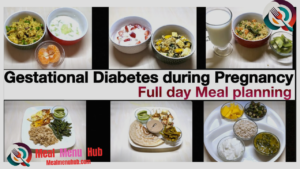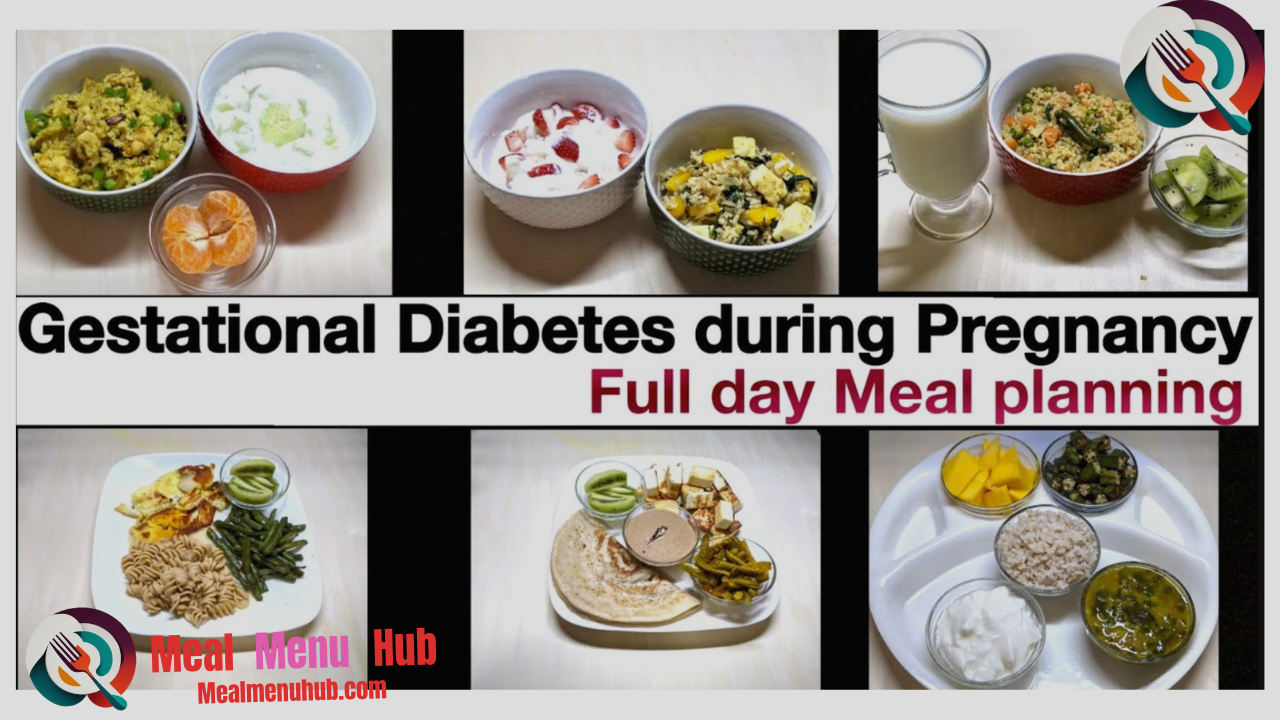Introduction to Gestational Diabetes
Gestational Diabetes Diet Gestational diabetes is a type of diabetes that develops during pregnancy, typically around the 24th week. It occurs when your body cannot produce enough insulin to regulate blood sugar levels effectively, leading to high blood sugar. Though gestational diabetes often resolves after childbirth, managing it during pregnancy is crucial to ensure the health of both mother and baby.Gestational Diabetes Diet

Diet plays a significant role in controlling gestational diabetes. By carefully selecting the right foods, monitoring blood sugar levels, and eating balanced meals, you can help keep your blood sugar stable and reduce the risk of complications such as preterm birth, high birth weight, and low blood sugar in the newborn.Gestational Diabetes Diet
How Diet Plays a Role in Managing Gestational Diabetes
When you’re pregnant, your body undergoes various hormonal changes that can impact insulin production and blood sugar regulation. In gestational diabetes, the body’s ability to use insulin efficiently is impaired. This is where a carefully planned diet comes in.Gestational Diabetes Diet
Managing blood sugar is essential not only for your health but also for your baby’s development. By focusing on foods that have a low glycemic index (GI), you can help stabilize your blood sugar and avoid sharp spikes or drops. The goal is to keep your blood sugar within a target range, as advised by your healthcare provider.Gestational Diabetes Diet
Key Principles of a Gestational Diabetes Diet
The primary goal of a gestational diabetes diet is to maintain steady blood sugar levels while still getting the nutrition needed for both the mother and baby. Key principles include:Gestational Diabetes Diet
Balanced Meals and Portion Control
It’s important to eat meals that include a balance of carbohydrates, protein, and healthy fats. Portion control helps prevent overeating, which can lead to blood sugar spikes.Gestational Diabetes Diet
Choosing Low Glycemic Index Foods
Foods with a low glycemic index (GI) are absorbed more slowly by the body, which helps maintain stable blood sugar levels. Examples include whole grains, legumes, and non-starchy vegetables.
The Role of Fiber and Healthy Fats
Fiber-rich foods, such as vegetables, whole grains, and legumes, help slow the absorption of sugar, preventing spikes. Healthy fats (like those from avocados, nuts, and olive oil) support overall health and promote satiety.Gestational Diabetes Diet
Foods to Eat on a Gestational Diabetes Diet
To keep blood sugar levels under control, focus on these types of foods:
Lean Proteins and Plant-Based Protein
- Skinless chicken, turkey, and fish
- Tofu, tempeh, and legumes (such as lentils and chickpeas)
- Eggs and Greek yogurt
Non-Starchy Vegetables
- Leafy greens (spinach, kale)
- Cruciferous vegetables (broccoli, cauliflower)
- Zucchini, cucumbers, and peppers
Whole Grains and Legumes
- Brown rice, quinoa, and oats
- Beans, lentils, and peas
Healthy Fats
- Avocados, olive oil, and nuts (almonds, walnuts)
- Fatty fish (salmon, mackerel)
Low Glycemic Fruits
- Berries (blueberries, strawberries, raspberries)
- Apples, pears, and citrus fruits
Foods to Avoid on a Gestational Diabetes Diet
Certain foods can cause rapid increases in blood sugar, so it’s best to limit or avoid them entirely:
Refined Sugars and Sugary Drinks
- Soda, fruit juices, and sweetened teas
- Candies, cakes, cookies, and pastries
Processed and Refined Carbs
- White bread, white rice, and pasta made with refined flour
- Packaged snacks, chips, and sugary cereals
High Glycemic Fruits
- Bananas, pineapples, and watermelon can be high in sugar and should be eaten in moderation.
Sample Meal Plan for Gestational Diabetes
Here’s a simple meal plan that follows the principles of a gestational diabetes diet:
Breakfast:
- Scrambled eggs with spinach and avocado
- A slice of whole-grain toast with almond butter
- A small handful of berries
Lunch:
- Grilled chicken salad with mixed greens, cucumbers, and olive oil vinaigrette
- A small serving of quinoa or brown rice
Dinner:
- Grilled salmon with roasted broccoli and sweet potato
- A side salad with olive oil dressing
Snacks:
- A small apple with peanut butter
- Greek yogurt with chia seeds
How to Manage Blood Sugar with Gestational Diabetes
Blood sugar management involves a combination of diet, exercise, and monitoring. Here are some tips to help control your blood sugar levels:
Frequent Meals and Snacks
Eating smaller, more frequent meals (about 5–6 meals a day) helps regulate blood sugar. Each meal should contain a good balance of protein, healthy fats, and low-glycemic carbs.
Monitor Your Blood Sugar Levels
Regular blood sugar checks are essential to track how your body responds to certain foods and activities. Your healthcare provider will guide you on when and how often to test.
Exercise and Physical Activity
Moderate physical activity, such as walking or swimming, can help improve insulin sensitivity and keep blood sugar levels in check. Always consult with your doctor before starting any new exercise program.
The Three Key Meals: Breakfast, Lunch, and Dinner
Breakfast
For a healthy breakfast, focus on foods that provide a good mix of protein, healthy fats, and complex carbs. Eggs with vegetables and avocado on whole grain toast is an excellent choice.
Lunch
A balanced lunch could be a salad with grilled chicken, a handful of quinoa, and a variety of non-starchy vegetables. This meal will keep your blood sugar levels steady until your next meal.
Dinner
Dinner can include grilled fish or chicken, paired with roasted vegetables and a serving of healthy carbs like sweet potatoes or brown rice.
Snacks for Gestational Diabetes
Healthy snacks help bridge the gap between meals and stabilize blood sugar. Opt for snacks that include protein, fiber, and healthy fats. Some examples include:
- A small handful of almonds
- Greek yogurt with chia seeds
- Carrot sticks with hummus
Meal Planning and Preparation Tips
Planning and preparing meals in advance can help you stay on track and avoid unhealthy food choices. Here are some tips for meal prep:
- Cook in bulk and store meals in the fridge or freezer for quick access.
- Focus on simple, whole foods that require minimal prep.
- Keep healthy snacks like cut vegetables, fruits, and nuts readily available.
Dealing with Cravings During Gestational Diabetes
It’s common to experience cravings, especially for sugary or high-carb foods. The key is to find healthier alternatives. Try:
- Satisfying sweet cravings with a piece of dark chocolate or berries.
- Drinking herbal teas or water with lemon to curb sugar cravings.
The Importance of Consistent Meal Timing
Maintaining consistent meal timing helps prevent large swings in blood sugar levels. Avoid skipping meals or waiting too long between meals, as this can cause your blood sugar to drop too low or rise too high.
Gestational Diabetes and Weight Management
Gestational diabetes doesn’t mean you should restrict calories excessively, but managing your weight is essential. By following a balanced diet, you can support healthy weight gain during pregnancy while keeping your blood sugar in check.
Expert Advice and Research on Gestational Diabetes Diet
Healthcare providers often recommend working with a dietitian to create a personalized meal plan. Research has shown that women with gestational diabetes who follow a low glycemic, balanced diet are more likely to maintain healthy blood sugar levels and have a healthier pregnancy outcome.
Conclusion: Managing Gestational Diabetes with the Right Diet
A well-balanced diet is one of the most effective ways to manage gestational diabetes. By focusing on nutrient-dense, low-glycemic foods, portion control, and consistent meal timing, you can help regulate your blood sugar levels and ensure a healthier pregnancy for both you and your baby.
FAQs About Gestational Diabetes Diet
1. Can I eat fruit on a gestational diabetes diet?
Yes, but it’s important to choose low-glycemic fruits like berries, apples, and pears, and avoid high-glycemic fruits in large quantities.
2. Is it necessary to follow a strict diet for gestational diabetes?
Yes, following a strict diet helps maintain stable blood sugar levels, which is essential for the health of both mother and baby.
3. Can I still eat carbohydrates with gestational diabetes?
Yes, but focus on complex carbs like whole grains and legumes, and avoid refined sugars and white bread.
4. How often should I monitor my blood sugar?
Your healthcare provider will guide you on how often to check your blood sugar, but typically it’s done before and after meals.
5. Can exercise help with managing gestational diabetes?
Yes, moderate physical activity can help improve insulin sensitivity and keep blood sugar levels stable. Always check with your doctor before starting any exercise program.
